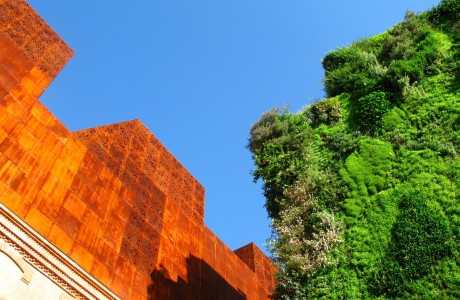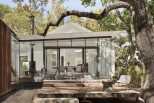A private redevelopment project that wanted to unite contemporary functionality and charm of unspoiled nature. An existing pre cottage…

Patrick Blanc is a botanist by profession who manages to create something wonderful. With its “Vertical Gardens” he offers a new green face to cities’ gray landscape, covering the walls of the palaces with ferns, mosses, plants of all kinds.
 It all started with a trip to Thailand done as a student: there he has noticed how the plants were able to grow on any surface, even the most unthinkable as long as they receive sufficient water and light. From here the inspiration he has translated into reality for his parisian house first. Today, at the age of 60 years, Patrick Blanc has designed and planted many vertical gardens for clients of all types and in all capitals of the world, from museums to public buildings, walls of halls or restaurants, until private homes. The first is 1986 ‘s garden and it is in the Parc de La Villette in Paris.
It all started with a trip to Thailand done as a student: there he has noticed how the plants were able to grow on any surface, even the most unthinkable as long as they receive sufficient water and light. From here the inspiration he has translated into reality for his parisian house first. Today, at the age of 60 years, Patrick Blanc has designed and planted many vertical gardens for clients of all types and in all capitals of the world, from museums to public buildings, walls of halls or restaurants, until private homes. The first is 1986 ‘s garden and it is in the Parc de La Villette in Paris.
 If the idea of Blanc is that the lawns and gardens should be an integral part of the architecture, which should surround it and wrap it, the first hurdle is the lack of free space in our cities: streets, parking lots and buildings are almost stacked on top of each other. The solution? The green goes vertical!
If the idea of Blanc is that the lawns and gardens should be an integral part of the architecture, which should surround it and wrap it, the first hurdle is the lack of free space in our cities: streets, parking lots and buildings are almost stacked on top of each other. The solution? The green goes vertical!
 But how is it possible to combine more plants and grow them vertically, with virtually no height limits? Blanc has devised a technique that involves the use of very thin felt panels for waterlogged roots and nutrients, which completely replace the soil without weighing on the supporting structure, made up of stringers and metal uprights. This is simply anchored to the wall, or it can even be free standing, leaving a blank space area, perfect as both thermal and acoustic insulation. A very thin (max 1 cm) PVC towel becomes rigid and impermeable base on which the felt boards will be attached. Finally, plants grow free and become the real visible layer, completely hiding all other layers that would disturb the design.
But how is it possible to combine more plants and grow them vertically, with virtually no height limits? Blanc has devised a technique that involves the use of very thin felt panels for waterlogged roots and nutrients, which completely replace the soil without weighing on the supporting structure, made up of stringers and metal uprights. This is simply anchored to the wall, or it can even be free standing, leaving a blank space area, perfect as both thermal and acoustic insulation. A very thin (max 1 cm) PVC towel becomes rigid and impermeable base on which the felt boards will be attached. Finally, plants grow free and become the real visible layer, completely hiding all other layers that would disturb the design.
 As frescoes, the vertical gardens decorate the walls of the metropolis, alternating with gray, characteristic color of our society, and they purify the air and they restore – at least partly – the contact with nature that seems to be lost.
As frescoes, the vertical gardens decorate the walls of the metropolis, alternating with gray, characteristic color of our society, and they purify the air and they restore – at least partly – the contact with nature that seems to be lost.




